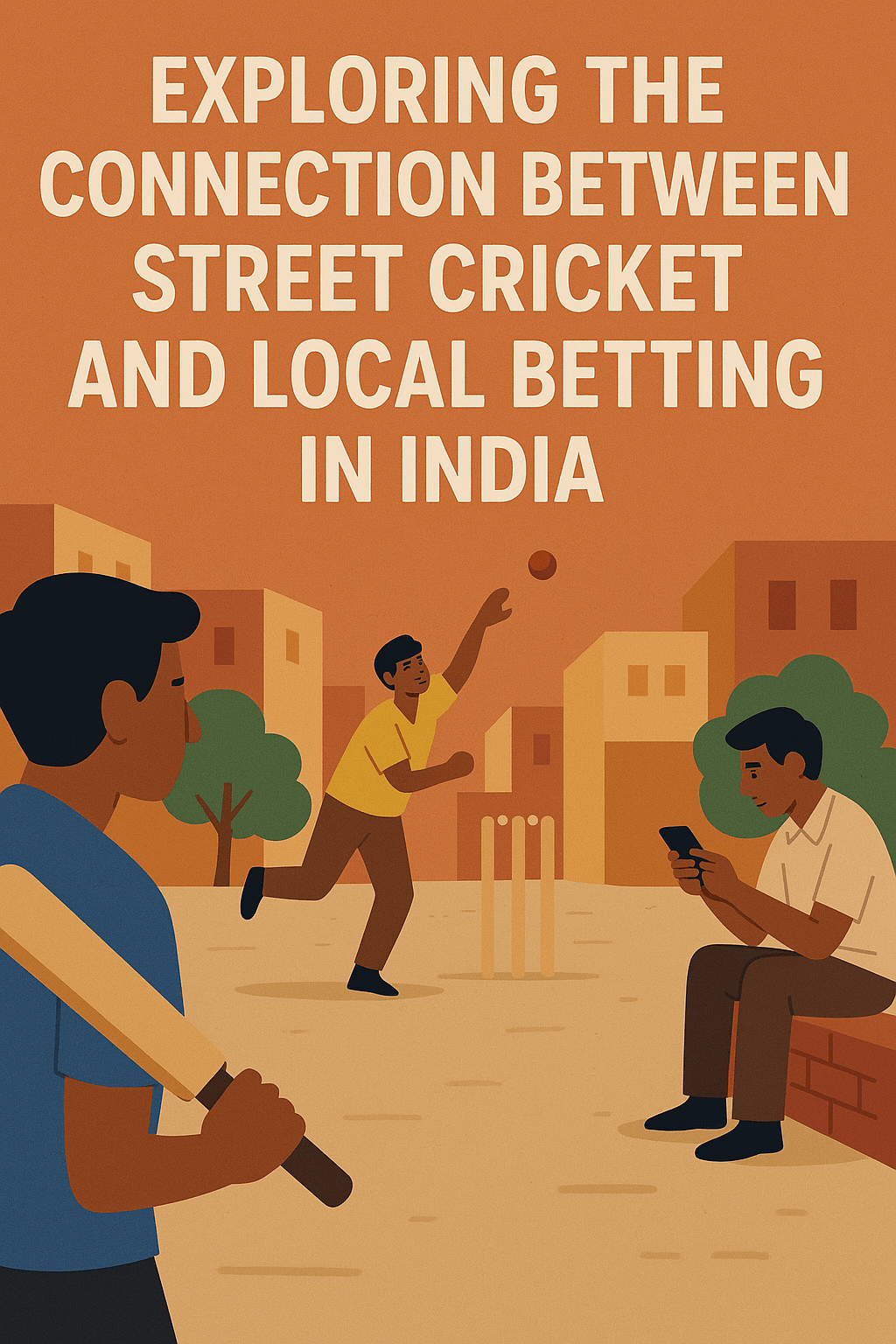Street cricket is far more than just a recreational activity in India; it’s a cultural phenomenon that has embedded itself deeply into the social fabric of the nation. From narrow alleyways in Mumbai to open grounds in small villages, the sound of bat hitting ball reverberates throughout the country at virtually any time of day. What makes this grassroots version of cricket particularly interesting is its intricate connection with informal betting practices that have evolved alongside the sport. These neighborhood matches often attract not just players and spectators but also those looking to place wagers on outcomes, creating a parallel economy that operates largely outside the formal gambling regulations. This relationship between street cricket and local betting provides a fascinating glimpse into how sports, community dynamics, and economic activities intersect in contemporary Indian society, reflecting both tradition and adaptation in an ever-changing cultural landscape.
The Cultural Significance of Street Cricket in Indian Society
Street cricket in India transcends mere sport to become a cultural institution that shapes community relationships, social hierarchies, and collective identities. With minimal equipment requirements—often just a bat, ball, and makeshift stumps—this accessible form of cricket democratizes participation across socioeconomic boundaries, allowing children from affluent neighborhoods to play alongside those from more modest backgrounds. The universality of street cricket has cemented its position as perhaps the most influential grassroots sporting activity in the country, serving as both entertainment and social glue in communities across urban and rural settings alike.
The Evolution of Street Cricket Rules
What distinguishes street cricket from its professional counterpart is its remarkable adaptability. Players ingeniously modify rules to accommodate spatial limitations and available resources. In narrow gullies, one-bounce catches might count as dismissals, while hitting the ball into certain areas might result in automatic “wickets.” These localized variations create unique playing styles that reflect the geographical and social constraints of each neighborhood, leading to distinct regional “dialects” of street cricket throughout India.
Talent Identification and Development
Street cricket serves as an informal but effective talent identification system for Indian cricket. Many professional players, including legends like Sachin Tendulkar and MS Dhoni, first developed their skills in these impromptu matches. The intense competition in street games, often played on challenging surfaces with unconventional equipment, fosters creativity and resilience that translate well to professional play. Scouts and cricket academies increasingly recognize street cricket’s role in developing players with unorthodox but effective techniques.
Community Building Through Competitive Play
Beyond athletic development, street cricket functions as a powerful community-building mechanism. Local tournaments organized during festivals or holidays can draw entire neighborhoods together, creating shared experiences that transcend religious, caste, and linguistic differences. These gatherings strengthen social bonds through the universal language of sport while establishing neighborhood pride and identity through team representation. The competitive nature of these matches naturally creates the conditions where spectator investment—emotional and, increasingly, financial—becomes an integral part of the experience.
Understanding the Informal Betting Systems in Street Cricket
The informal betting ecosystem surrounding street cricket has evolved into a sophisticated parallel economy with its own unwritten rules, trusted intermediaries, and dispute resolution mechanisms. Unlike commercial gambling operations, street cricket betting typically begins with small wagers between friends and neighbors that enhance the excitement of watching matches. These friendly bets gradually developed into more organized systems in many areas, particularly during local tournaments where significant crowds gather to watch talented local players compete. The betting occurs through a web of personal relationships rather than formal bookmaking, relying heavily on community trust and reputation.
What makes this betting system unique is its deeply communal nature. Participants typically know each other personally, creating accountability that formal betting establishments cannot replicate. Bets range from token amounts placed for entertainment value to more substantial wagers during high-profile local tournaments. The odds are rarely calculated mathematically but instead emerge organically based on collective perceptions of team strengths, individual player capabilities, and historical performance in similar conditions.
- Traditional “side bets” on specific outcomes like next batsman dismissed
- “Ball-by-ball” betting on whether runs will be scored on the next delivery
- “Player performance” wagers on individual achievements like half-centuries
- “Match outcome” betting with flexible odds that shift during play
- “Fantasy team” selections where spectators create imaginary teams from participants
- “Situation-based” betting that focuses on specific scenarios during crucial moments
- “Tournament progression” wagers on which teams advance to later stages
The flexibility of street cricket betting allows participants to engage at comfort levels that match their risk tolerance and financial capacity. Most importantly, these systems operate primarily as community entertainment rather than profit-seeking enterprises, with money typically circulating within the local ecosystem rather than flowing to outside commercial interests. This informal economy creates additional layers of engagement with the sport, transforming passive spectators into active participants with tangible stakes in match outcomes.
Popular Betting Practices in Street Cricket Matches
The landscape of betting practices in street cricket encompasses a rich variety of wagering traditions that have developed organically across different regions of India. These practices reflect local preferences, cultural attitudes toward risk, and the specific nature of the cricket being played in each community. Understanding these betting customs provides insight into how deeply integrated gambling has become with grassroots cricket, creating a symbiotic relationship that enhances engagement with the sport while generating economic activity outside formal channels.
Performance-Based Betting Models
The most prevalent form of betting in street cricket focuses on individual player performances within matches. Spectators place wagers on specific achievements such as the number of runs a batsman will score, whether a bowler will take multiple wickets, or if a player will hit a six during their time at the crease. These performance-based bets are particularly popular because they allow for continuous engagement throughout a match rather than waiting for the final result. The immediacy of these outcomes creates a dynamic betting environment where participants can experience multiple wins or losses during a single game, maintaining interest even in one-sided contests.
Handicap Systems and Equalization Techniques
To maintain betting interest when teams are mismatched in ability, sophisticated handicap systems have evolved in street cricket betting. These might include giving the weaker team additional runs at the start of their innings, allowing them extra players, or imposing fielding restrictions on the stronger side. These equalization techniques ensure betting remains attractive even when skill disparities exist, as they effectively normalize the odds and create uncertainty about outcomes. The community negotiates these handicaps collectively, with experienced local cricket followers acting as informal arbiters who determine appropriate adjustments.
Tournament Progression and Knockout Stage Betting
Local cricket tournaments generate particular excitement in betting circles, with wagers increasing in both frequency and value as competitions progress toward final rounds. Complex betting pools emerge where participants predict tournament brackets, select ultimate winners, or bet on which players will receive individual honors. These longer-term wagers create sustained engagement throughout tournament durations, sometimes spanning several weeks. The culmination of these tournaments often sees the highest-stakes betting of the year within communities, with significant sums changing hands based on championship outcomes.
The Socioeconomic Impact of Street Cricket Betting
The informal betting economy surrounding street cricket generates significant financial flows that impact local communities in multifaceted ways. While precise figures remain elusive due to the underground nature of these activities, conservative estimates suggest that during major local tournaments, the cumulative value of wagers can reach substantial amounts even in modest neighborhoods. This economic activity creates ripple effects throughout community ecosystems, influencing spending patterns, small business revenues, and even investment decisions among regular participants.
The socioeconomic dimensions of street cricket betting extend beyond simple monetary exchanges to influence social status, community relationships, and economic opportunities. Successful bettors often gain reputation and influence within their communities, while consistent losers may face financial hardship and diminished standing. This creates a complex social dynamic where betting outcomes can reshape community hierarchies and influence decision-making authority on matters beyond sports.
- Revenue generation for local vendors who sell refreshments and cricket equipment during matches with betting interest
- Supplementary income for skilled players who may receive compensation from betting beneficiaries
- Development of financial management skills among regular participants who track betting outcomes and adjust strategies
The economic benefits must be weighed against potential social costs, including gambling-related conflicts that occasionally disrupt community harmony. When significant sums are involved, disagreements about outcomes or payment obligations can escalate into lasting disputes. Furthermore, the presence of betting may incentivize match-fixing at the local level, potentially undermining the integrity of the sport that serves as the community’s focal point.
Despite these challenges, street cricket betting can function as an informal financial institution in communities with limited access to banking services. The circulation of money through betting creates liquidity and enables small-scale capital formation that might otherwise be unavailable. Winnings from cricket betting are frequently channeled into productive investments such as education expenses, home improvements, or small business development.
Legal Considerations and Risks Associated with Informal Cricket Betting
The legal status of street cricket betting exists in a complex regulatory gray area that varies significantly across Indian states. While gambling laws generally prohibit betting on sports, enforcement at the neighborhood level remains inconsistent and often deprioritized by local authorities who recognize its cultural embeddedness. This ambiguous legal position creates uncertainty for participants, who must navigate the tension between widespread community acceptance and technical illegality of their activities. Understanding this legal landscape helps contextualize the risks faced by those who engage in the betting ecosystem surrounding street cricket.
The absence of legal protections creates vulnerability for participants, particularly in disputes involving significant sums. Without recourse to formal dispute resolution mechanisms, bettors must rely entirely on community enforcement and personal reputation to ensure fair treatment. This can lead to power imbalances where socially dominant individuals exercise disproportionate influence over betting outcomes and settlement terms. For younger participants or those with limited social capital, these dynamics may create exploitation risks that wouldn’t exist in regulated environments.
Beyond legal considerations, regular participation in cricket betting carries financial risks that can impact individual and family welfare. The informal nature of these betting systems means they lack the responsible gambling safeguards increasingly incorporated into regulated betting markets. Without deposit limits, cooling-off periods, or self-exclusion options, vulnerable individuals may develop problematic gambling behaviors that remain unaddressed until significant harm occurs. Community awareness of these risks varies widely, with some neighborhoods developing informal support systems for those experiencing negative consequences while others normalize excessive betting regardless of outcomes.
Preserving Tradition While Promoting Responsibility
The deep cultural connections between street cricket and local betting practices represent a tradition worth understanding within its proper context. These activities have co-evolved over generations, creating complex social institutions that provide entertainment, community bonding, and economic activity in neighborhoods throughout India. Rather than dismissing these practices entirely, a nuanced approach recognizes their cultural significance while addressing legitimate concerns about their potential downsides.
Communities across India have begun developing informal guidelines that promote responsible engagement with cricket betting while preserving its social benefits. These grassroots efforts focus on transparency, moderation, and age-appropriate participation that minimizes harm while maintaining the excitement and community involvement that betting brings to street cricket. Local leaders increasingly recognize their role in modeling responsible behavior, particularly for younger community members who observe and emulate adult practices.
The future of street cricket betting likely involves finding balance between tradition and responsibility—maintaining the community-building aspects while mitigating potential harms. This balance requires ongoing dialogue within communities about acceptable practices, appropriate stake levels, and protective measures for vulnerable participants. By approaching these conversations with cultural sensitivity rather than moral absolutism, communities can preserve valuable traditions while adapting them to contemporary understanding of gambling-related risks.



